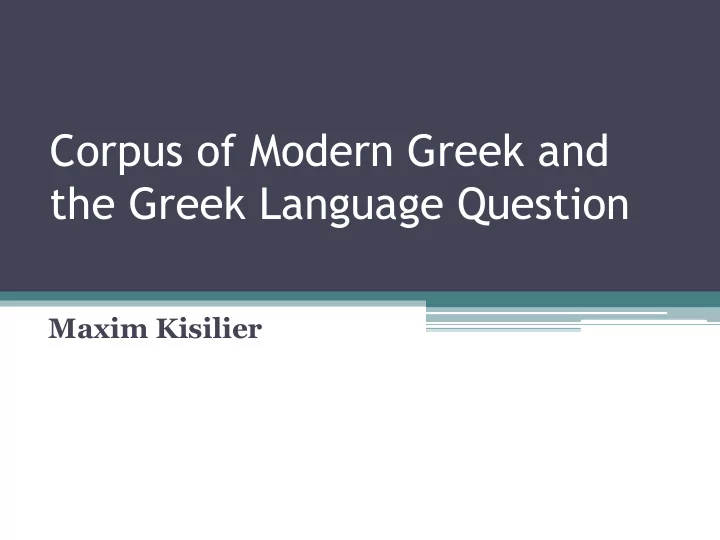

Corpus of Modern Greek and the Greek Language Question Maxim Kisilier
• 2011- 2015: RAS program “Corpus Linguistics”: 14 copora including Albanian and Modern Greek (http://web-corpora.net) • Followed the model of the Eastern Armenian National Corpus (http://www.eanc.net)
Corpus of Modern Greek • http://web-corpora.net/GreekCorpus/search/ • Size: 35,7 million tokens • Collection of written texts mostly from contemporary newspapers • No disambiguation: each word is annotated with all possible analyses
Corpus of Modern Greek • http://web-corpora.net/GreekCorpus/search/ • Size: 35,7 million tokens • Collection of written texts mostly from contemporary newspapers • No disambiguation: each word is annotated with all possible analyses • Occasional mistakes in the grammatical tags as annotation and compilation of the dictionary were automatic
Corpus of Modern Greek • No access to the full text
Corpus of Modern Greek • No access to the full text • Created by linguists • Created for linguists • Created for non-professional users • User-friendly interface • Advanced options
Corpus of Modern Greek • No access to the full text • Created by linguists • Created for linguists • Created for non-professional users • User-friendly interface • Advanced options
Corpus of Modern Greek • No access to the full text • Created by linguists • Created for linguists • Created for non-professional users • User-friendly interface • Advanced options
Corpus of Modern Greek • No access to the full text • Created by linguists • Created for linguists • Created for non-professional users • User-friendly interface • Advanced options
The Greek Language Question • Diglossia or Polyglossia (Browning 1983) • Terms Katharevousa and Demotic Greek appeared in 1796 and 1818, but in AG: literary dialects and spoken dialects in Middle Ages: historiography, hagiography, literature in vernacular/dialectal literature, dialects
The Greek Language Question • Primary meaning of the terms katharevousa and demotic Greek differs from the modern one • Katharevousa Adamantios Korais Yakovakis Neroulos Emmanouil Roidis Georgios Viziinos Georgios Hadzidakis Andreas Embirikos (prose)
The Greek Language Question • Primary meaning of the terms katharevousa and demotic Greek differs from the modern one • Katharevousa Yannis Psycharis Adamantios Korais Stratis Myrivilis • Demotic Greek Yakovakis Neroulos Antonis Samorakis Emmanouil Roidis Nikos Kazantzakis Georgios Viziinos Zirana Zatelli Georgios Hadzidakis Rea Galanaki Andreas Embirikos (prose)
The Greek Language Question • Primary meaning of the terms katharevousa and demotic Greek differs from the modern one • Katharevousa Yannis Psycharis Stratis Myrivilis • Demotic Greek ? Antonis Samorakis • Poetry Nikos Kazantzakis Zirana Zatelli Rea Galanaki
Alexandros Papadiamandis • 1851-1911
Alexandros Papadiamandis • 1851-1911 • Many archaic features: nominal morphology - � ὴ � �������� vs. � ὴ � �������
Alexandros Papadiamandis • 1851-1911 • Many archaic features: nominal morphology - � ὴ � ������ ιν vs. � ὴ � ������ η
Alexandros Papadiamandis • 1851-1911 • Many archaic features: nominal morphology - � ὴ � �������� vs. � ὴ � ������� verb morphology - ἐ ������ vs. �������α , ἧ �α� vs. ��α� vocabulary - � �ω� vs. ���� , ο � � vs. φ���
Alexandros Papadiamandis BUT • Lexical borrowings from: Turkish – �α�ά� (< tamam ) Albanian - ��ο�πα (< çupë ) Slavic – �ά��ο� (< �л�то ) • Features of vernacular: π��ά vs. π�ά
Alexandros Papadiamandis BUT • Lexical borrowings from: Turkish – �α�ά� (< tamam ) Albanian - ��ο�πα (< çupë ) Slavic – �ά��ο� (< �л�то ) • Features of vernacular: π λ �ά vs. π�ά
Alexandros Papadiamandis BUT • Lexical borrowings from: Turkish – �α�ά� (< tamam ) Albanian - ��ο�πα (< çupë ) Slavic – �ά��ο� (< �л�то ) • Features of vernacular: π��ά vs. π�ά • Dialectal features: ��ου���ω vs. ��ω���ω
Conclusions • Tags Katharevousa and Demotic Greek for texts or/and authors is not a good solution • Katharevousa or Demotic Greek ? Corpus Who should decide? User
Conclusions • Tags Katharevousa and Demotic Greek for texts or/and authors is not a good solution • Katharevousa or Demotic Greek ? Corpus Who should decide? User
Conclusions • Choice between polytonic and monotonic • Advanced search options (choice of flexions or inflexion types if possible)
Thank you for your attention!
Recommend
More recommend